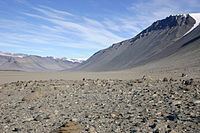 | ||
An Antarctic oasis is a large area naturally free of snow and ice in the otherwise ice-covered continent of Antarctica.
Contents
Geology
In Antarctica there are, in addition to mountain tops and nunataks, other natural snow- and ice-free areas often referred to as "Antarctic oasis" or "dry valleys". These areas are surrounded by the Antarctic ice sheet or in coastal areas situated between the ice sheet and the Antarctic ice shelves.
Antarctic oases and dry valleys develop in areas with particular regional weather patterns and geography. These areas have very low humidity and precipitation. Although these areas are very cold, sufficient solar energy is absorbed by the ground to melt what little snow does fall, or else it is scoured or sublimated by katabatic winds leaving the underlying rock exposed.
Despite usually extreme aridity, some plants, in the form of bryophytes and lichens, can survive in Antarctic oases.
Geography
The larger oases are:
